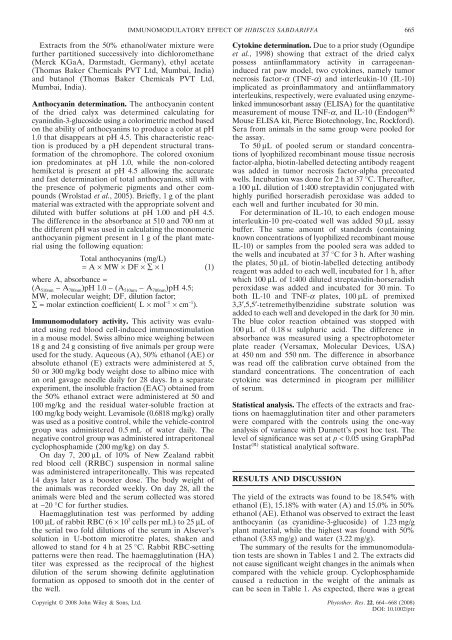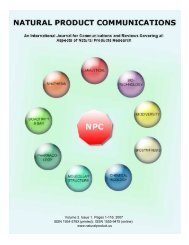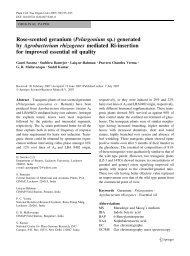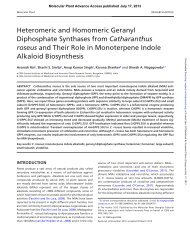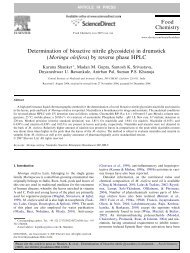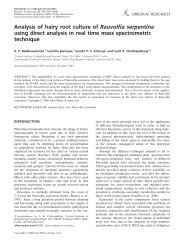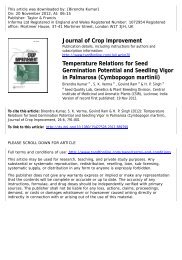Immunomodulatory effect of extracts of Hibiscus ... - ResearchGate
Immunomodulatory effect of extracts of Hibiscus ... - ResearchGate
Immunomodulatory effect of extracts of Hibiscus ... - ResearchGate
Create successful ePaper yourself
Turn your PDF publications into a flip-book with our unique Google optimized e-Paper software.
IMMUNOMODULATORY EFFECT OF HIBISCUS SABDARIFFA 665Extracts from the 50% ethanol/water mixture werefurther partitioned successively into dichloromethane(Merck KGaA, Darmstadt, Germany), ethyl acetate(Thomas Baker Chemicals PVT Ltd, Mumbai, India)and butanol (Thomas Baker Chemicals PVT Ltd,Mumbai, India).Anthocyanin determination. The anthocyanin content<strong>of</strong> the dried calyx was determined calculating forcyanindin-3-glucoside using a colorimetric method basedon the ability <strong>of</strong> anthocyanins to produce a color at pH1.0 that disappears at pH 4.5. This characteristic reactionis produced by a pH dependent structural transformation<strong>of</strong> the chromophore. The colored oxoniumion predominates at pH 1.0, while the non-coloredhemiketal is present at pH 4.5 allowing the accurateand fast determination <strong>of</strong> total anthocyanins, still withthe presence <strong>of</strong> polymeric pigments and other compounds(Wrolstad et al., 2005). Briefly, 1 g <strong>of</strong> the plantmaterial was extracted with the appropriate solvent anddiluted with buffer solutions at pH 1.00 and pH 4.5.The difference in the absorbance at 510 and 700 nm atthe different pH was used in calculating the monomericanthocyanin pigment present in 1 g <strong>of</strong> the plant materialusing the following equation:Total anthocyanins (mg/L)= A × MW × DF × ∑ × l (1)where A, absorbance =(A 510nm − A 700nm )pH 1.0 − (A 510nm − A 700nm )pH 4.5;MW, molecular weight; DF, dilution factor;∑ = molar extinction coefficient( L × mol −1 × cm −1 ).<strong>Immunomodulatory</strong> activity. This activity was evaluatedusing red blood cell-induced immunostimulationin a mouse model. Swiss albino mice weighing between18 g and 24 g consisting <strong>of</strong> five animals per group wereused for the study. Aqueous (A), 50% ethanol (AE) orabsolute ethanol (E) <strong>extracts</strong> were administered at 5,50 or 300 mg/kg body weight dose to albino mice withan oral gavage needle daily for 28 days. In a separateexperiment, the insoluble fraction (EAC) obtained fromthe 50% ethanol extract were administered at 50 and100 mg/kg and the residual water-soluble fraction at100 mg/kg body weight. Levamisole (0.6818 mg/kg) orallywas used as a positive control, while the vehicle-controlgroup was administered 0.5 mL <strong>of</strong> water daily. Thenegative control group was administered intraperitonealcyclophosphamide (200 mg/kg) on day 5.On day 7, 200 μL <strong>of</strong> 10% <strong>of</strong> New Zealand rabbitred blood cell (RRBC) suspension in normal salinewas administered intraperitoneally. This was repeated14 days later as a booster dose. The body weight <strong>of</strong>the animals was recorded weekly. On day 28, all theanimals were bled and the serum collected was storedat −20 °C for further studies.Haemagglutination test was performed by adding100 μL <strong>of</strong> rabbit RBC (6 × 10 3 cells per mL) to 25 μL <strong>of</strong>the serial two fold dilutions <strong>of</strong> the serum in Alsever’ssolution in U-bottom microtitre plates, shaken andallowed to stand for 4 h at 25 °C. Rabbit RBC-settingpatterns were then read. The haemagglutination (HA)titer was expressed as the reciprocal <strong>of</strong> the highestdilution <strong>of</strong> the serum showing definite agglutinationformation as opposed to smooth dot in the center <strong>of</strong>the well.Cytokine determination. Due to a prior study (Ogundipeet al., 1998) showing that extract <strong>of</strong> the dried calyxpossess antiinflammatory activity in carrageenaninducedrat paw model, two cytokines, namely tumornecrosis factor-α (TNF-α) and interleukin-10 (IL-10)implicated as proinflammatory and antiinflammatoryinterleukins, respectively, were evaluated using enzymelinkedimmunosorbant assay (ELISA) for the quantitativemeasurement <strong>of</strong> mouse TNF-α, and IL-10 (Endogen (R)Mouse ELISA kit, Pierce Biotechnology, Inc, Rockford).Sera from animals in the same group were pooled forthe assay.To 50 μL <strong>of</strong> pooled serum or standard concentrations<strong>of</strong> lyophilized recombinant mouse tissue necrosisfactor-alpha, biotin-labelled detecting antibody reagentwas added in tumor necrosis factor-alpha precoatedwells. Incubation was done for 2 h at 37 °C. Thereafter,a 100 μL dilution <strong>of</strong> 1:400 streptavidin conjugated withhighly purified horseradish peroxidase was added toeach well and further incubated for 30 min.For determination <strong>of</strong> IL-10, to each endogen mouseinterleukin-10 pre-coated well was added 50 μL assaybuffer. The same amount <strong>of</strong> standards (containingknown concentrations <strong>of</strong> lyophilized recombinant mouseIL-10) or samples from the pooled sera was added tothe wells and incubated at 37 °C for 3 h. After washingthe plates, 50 μL <strong>of</strong> biotin-labelled detecting antibodyreagent was added to each well, incubated for 1 h, afterwhich 100 μL <strong>of</strong> 1:400 diluted streptavidin-horseradishperoxidase was added and incubated for 30 min. Toboth IL-10 and TNF-α plates, 100 μL <strong>of</strong> premixed3,3′,5,5′-tetremethylbenzidine substrate solution wasadded to each well and developed in the dark for 30 min.The blue color reaction obtained was stopped with100 μL <strong>of</strong> 0.18 M sulphuric acid. The difference inabsorbance was measured using a spectrophotometerplate reader (Versamax, Molecular Devices, USA)at 450 nm and 550 nm. The difference in absorbancewas read <strong>of</strong>f the calibration curve obtained from thestandard concentrations. The concentration <strong>of</strong> eachcytokine was determined in picogram per milliliter<strong>of</strong> serum.Statistical analysis. The <strong>effect</strong>s <strong>of</strong> the <strong>extracts</strong> and fractionson haemagglutination titer and other parameterswere compared with the controls using the one-wayanalysis <strong>of</strong> variance with Dunnett’s post hoc test. Thelevel <strong>of</strong> significance was set at p < 0.05 using GraphPadInstat (R) statistical analytical s<strong>of</strong>tware.RESULTS AND DISCUSSIONThe yield <strong>of</strong> the <strong>extracts</strong> was found to be 18.54% withethanol (E), 15.18% with water (A) and 15.0% in 50%ethanol (AE). Ethanol was observed to extract the leastanthocyanin (as cyanidine-3-glucoside) <strong>of</strong> 1.23 mg/gplant material, while the highest was found with 50%ethanol (3.83 mg/g) and water (3.22 mg/g).The summary <strong>of</strong> the results for the immunomodulationtests are shown in Tables 1 and 2. The <strong>extracts</strong> didnot cause significant weight changes in the animals whencompared with the vehicle group. Cyclophosphamidecaused a reduction in the weight <strong>of</strong> the animals ascan be seen in Table 1. As expected, there was a greatCopyright © 2008 John Wiley & Sons, Ltd. Phytother. Res. 22, 664–668 (2008)DOI: 10.1002/ptr


